
No-weld Inset Aluminium Slat Gates
Introduction
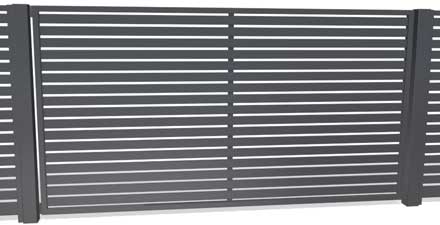
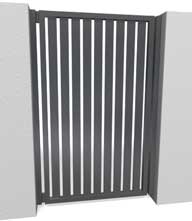
Gates with Inset Slats have the slats screwed directly into a slot in the side of a No-weld frame horizontally or vertically with No-weld Box Section framing used elsewhere giving a unique clean look, possible only because there are no welds and no screws or gaps visible. Swing gates can go up to 4m wide x 2m high and sliding gates 6m wide x 2m high. Gates wider than 1.5m with slats fitted horizontally require vertical supports behind the slats every 1.5m or so.
Sliding gates do require a sliding gate channel see No-weld sliding gates and No-weld Telescopic Sliding Gates to learn more.
No-weld frames and aluminium slats may have many different finishes READ MORE
What's included in a No-weld Inset Aluminium Slat Gate DIY Kit?
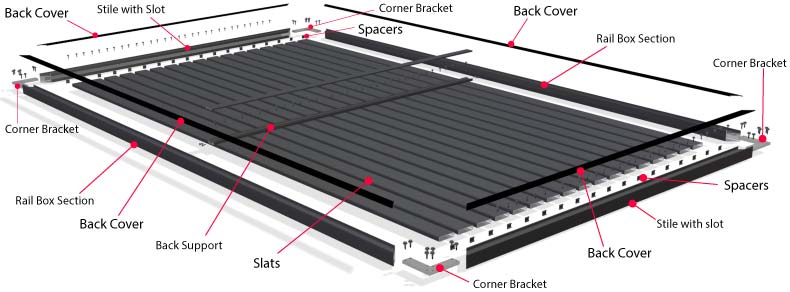
Kits come pre-cut and drilled ready to assemble. Gates with horizontal and Vertical slats available.
Things to Consider
Slat widths. The most popular slat width is 65mm, which is 16mm thick but you can also have 38mm, 100mm or 150mm wide slats all 16mm thick.
Gate Height or Width verses Slat Gap. No-weld gates with slats set into the frame can have the spacers cut so they fit in the gap between the slats at a precise gap so the slats will fit neatly into a custom height or width of the gate without the assembler having to work out the spacing. Spacers are only practical from 8mm gaps or wider.
Slats can be hard up against each other too with no gap at all if desired although the exact height of the gate will be determined by the slat count and the exact width of each slat. That is if you want a gate 1500mm high using 65mm wide slats with no gap you will need 22 x slats + a top and bttom rail 40mm wide comes to , which should be 1510mm high although the exact width of slats can vary by up to 0.4mm and the thickness of powder coating can add another 0.3mm or so to the width of each slat so the gate could be 22 x 0.7m = 15.4mm higher.
Making No-weld Inset Aluminium Slat Gate Kits yourself.
If you're in the gate or fence business and want to save money as well as get jobs done faster (customers like it done fast), you can do so by making No-weld slat gate kits up yourself. All you need is a good mitre saw, lengths of No-weld framing, slats and hardware. If you keep No-weld materials in stock you could custom make slat gate kits up yourself in a matter of hours onsite, assemble them and then install, so you don't need a workshop just somewhere to store the material and a suitable vehicle. This will give you a significant edge over your competition both time wise and price wise.
You can order No-weld framing, slats and hardware at the No-weld Online Shop.
Making these gates requires mitred cuts, for technique on how to mitre cut No-weld framing accurately and cleanly with no burrs and drill holes for corner brackets see our our Guide to Cutting and Drilling No-weld Framing. There are other styles of gates too see What can be Made with No-weld.
Trade Customers
If you become one of our trade customers we can pass work onto you for free for No-weld gates, infill panels and fencing. You can either work as a fabricator only for others to install or as a fabricator and installer. See below on how No-weld set into the frame slat gates are assembled.
For more information see our No-weld for Trade and Wholesale page
Assembly Instructions for No-weld Inset Slat Gates
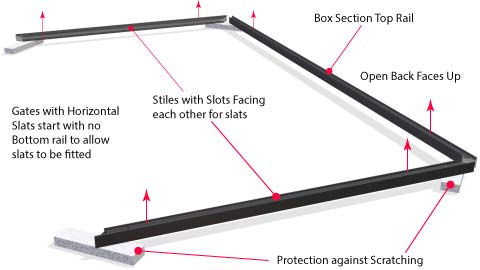
Place the pre-cut and drilled frame members on clean blocks of polystyrene foam or similar non-scratching material laid out on a flat surface with the open back faces up. Gates with horizontal slats should have the top rail only fitted before the slats.
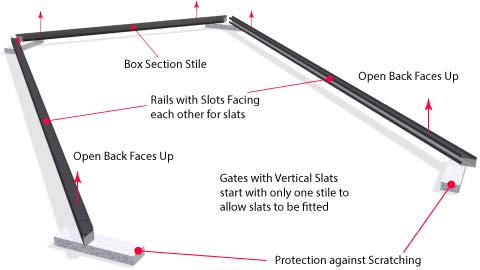
Gates with vertical slats should have only one stile fitted before the slats, it doesn't matter which stile. Slats are fitted into the frame members with a slot, other framing is box section that is it has no slot.
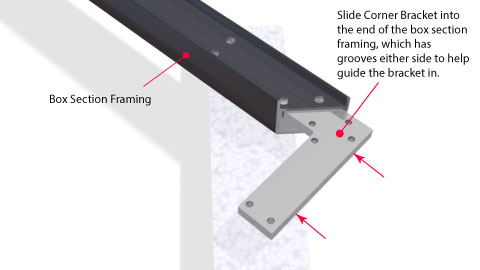
Corner brackets are required to hold the frame together. These are fitted by sliding them into the ends of the Box Section framing to begin with, which has grooves in both sides to help guide the bracket in.
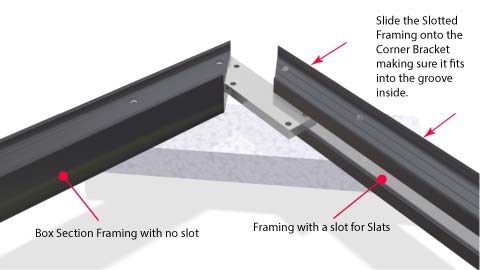
Then slide the slotted frame onto the corner bracket, which also has a groove in one side that must be carefully fitted onto the corner bracket otherwise the screw holes won't align correctly.
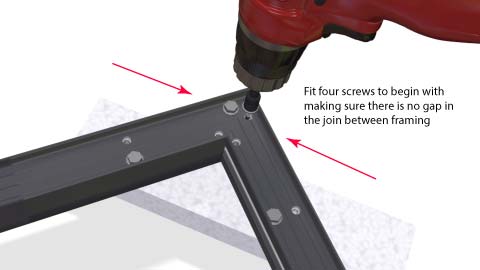
Then fit four of the larger tek screws into each corner bracket to begin with using a cordless drill in the pattern illustrated above making sure there's no gap in the join between framing. The rest of the screws will be fitted later.
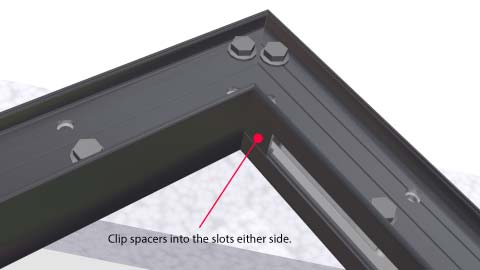
For gates with gaps between their slats, spacers need to be clipped in first so there is a gap between the frame and first slat, see Guide to fitting No-weld Spacers to learn how to do this.
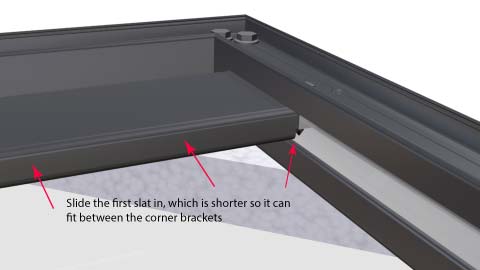
Then slide the first slat in, which is shorter than the others because so it can fit between the corner brackets of the frame, slide it hard up against the spacers.

Then fit the next spacers and slats, which will be full length and can be inserted on an angle rather than from one end. If the gap is smaller than 20mm the second slat will have small notches to fit around the corner brackets.
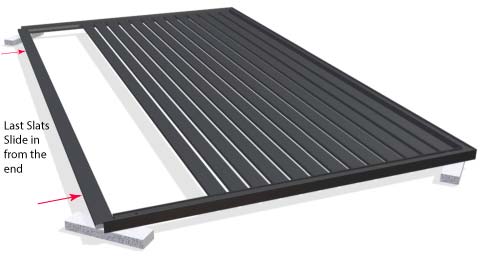
As you approach the end there will be a point where the slats will need to slide in from the end. If the gap is less than 20mm the second to last slat will have notches to fit around the corner brackets.
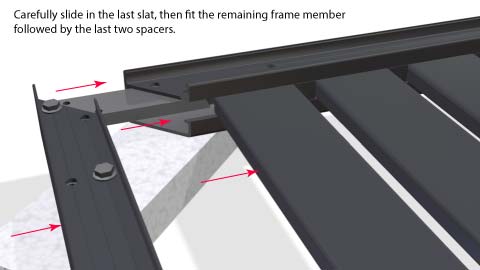
The last slat will be shorter so it will fit between the corner brackets so slide it in carefully because it only just fits into the slots. Then fit the last frame member followed by the last two spacers.
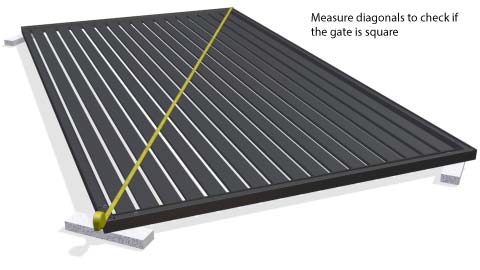
Then make sure the gate is square by checking the diagonals are the same with a tape measure. If not square, loosen all corner bracket screws a little and pull the longer diagonal in by half the difference then re-tighten and re-check.

Fit the rest of the corner bracket screws then screw in the slats. The first and last slats are fitted between corner brackets so they cannot be screwed but they are held in there well so won't come out.
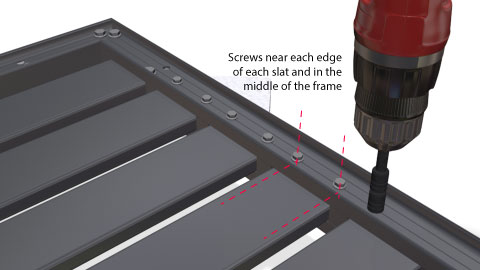
Screws for the slats must be near the edge of the slat, with two screws each end of each slat and in the middle of the frame. Use another block under the area being screwed to prevent the frame bowing.

Gates with Horizontal slats wider than 1.5m need to have one or more vertical back supports screwed in behind the slats.
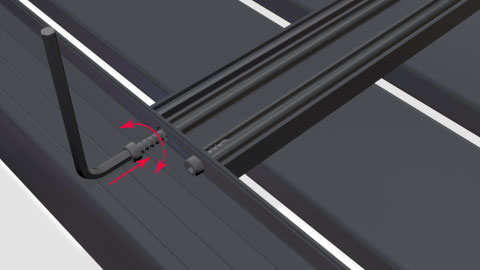
Vertical back supports are attached to the rails with small cap screws so an Allan key can be used to screw them in at the required angle.
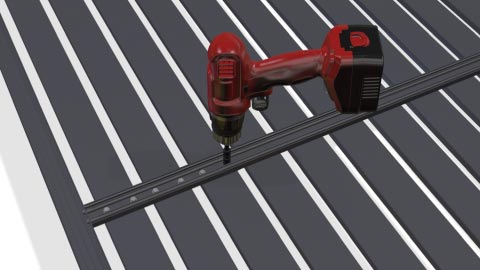
The slats are then screwed to the vertical back support with two screws per slat near the edge as with the rest of the frame.
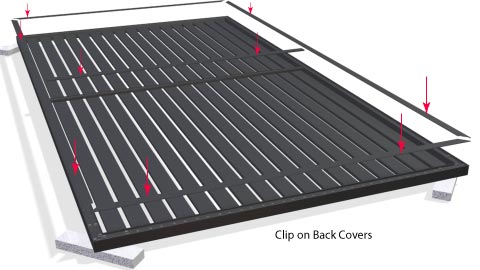
Covers are then clipped into the back of the frame to cover the screws. See Guide to Fitting No-weld Hardware for technique on how to do this.
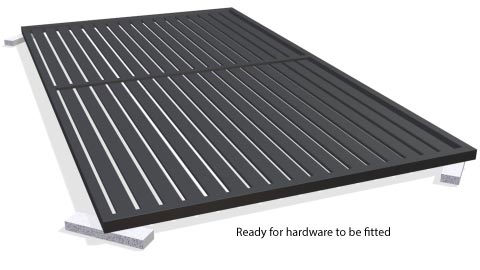
Once the covers are fitted hardware such as hinges, latch, stop or guide rail can be fitted to the back of the frame. See Guide to Fitting No-weld Hardware.